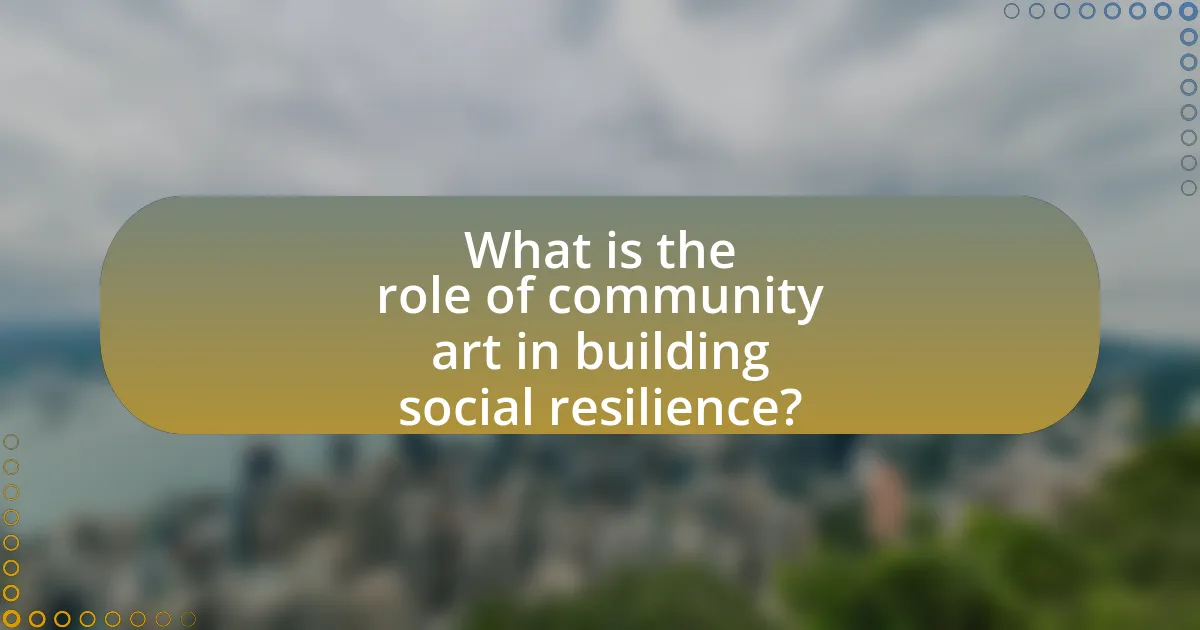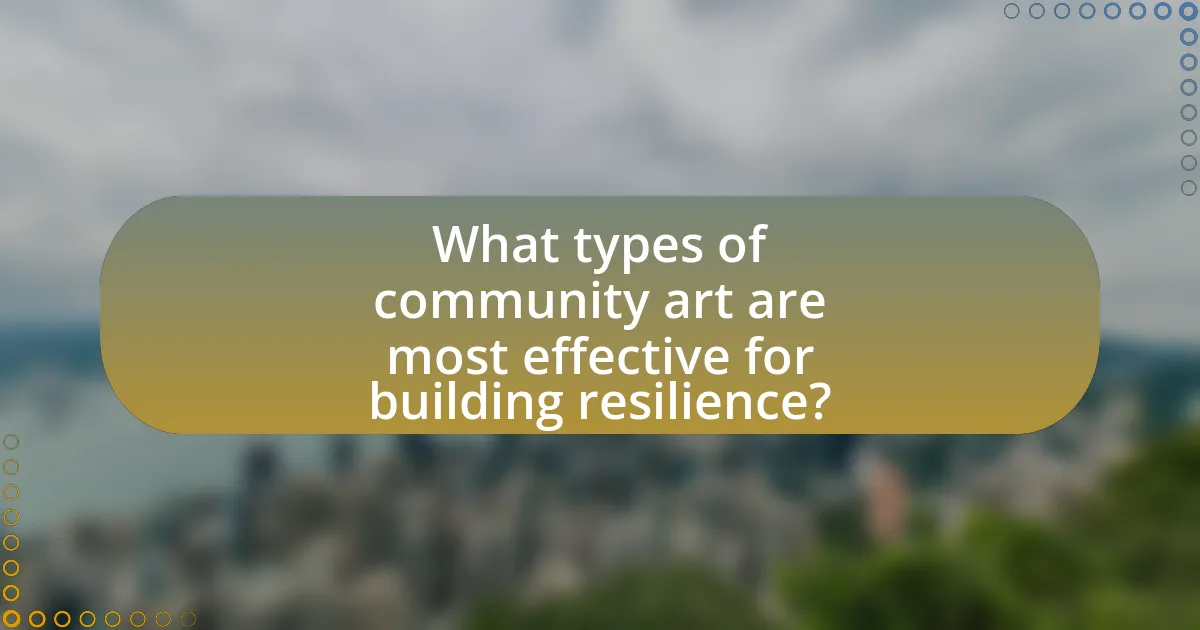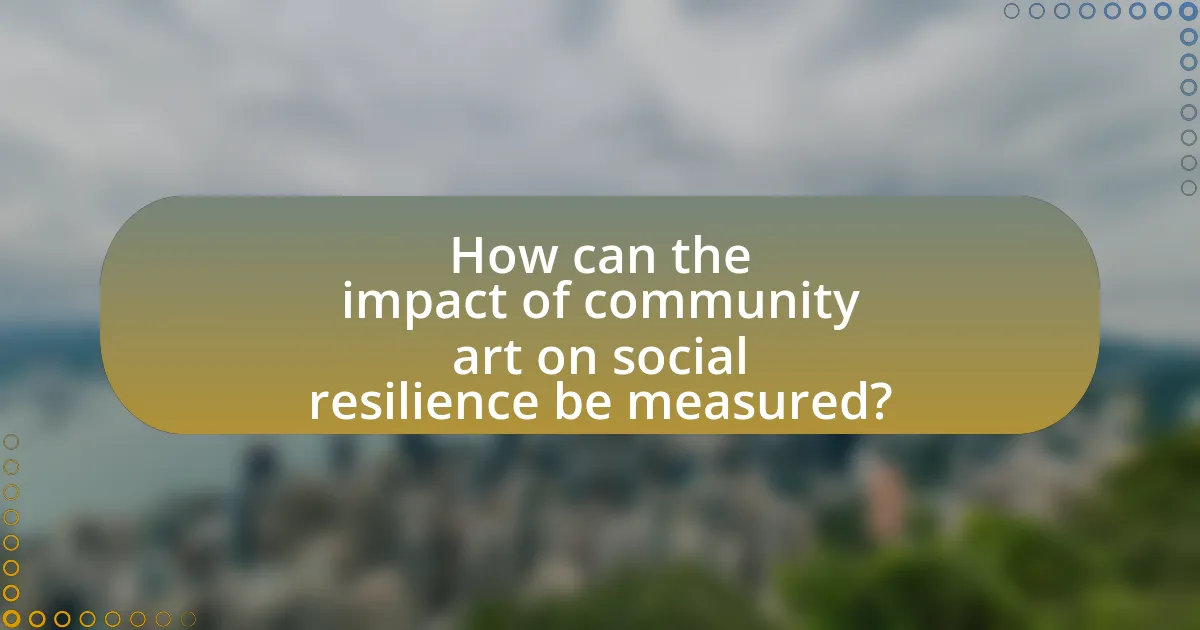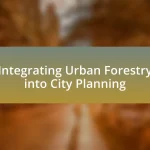Community art plays a vital role in building social resilience by fostering connections among individuals and enhancing community identity. It encourages participation through collaborative projects, which strengthens social networks and promotes a sense of belonging. Research indicates that communities engaged in artistic initiatives experience improved mental health, increased civic engagement, and higher levels of trust and cooperation among residents. The article explores how community art contributes to social cohesion, addresses challenges such as social isolation and economic disparity, and highlights effective practices for implementing art initiatives that empower local voices and enhance community well-being. Additionally, it examines the impact of community art on resilience during crises and its role in addressing social inequalities.

What is the role of community art in building social resilience?
Community art plays a crucial role in building social resilience by fostering connections among individuals and enhancing community identity. Through collaborative projects, community art encourages participation, which strengthens social networks and promotes a sense of belonging. Research indicates that communities engaged in artistic initiatives experience improved mental health and increased civic engagement, as seen in studies like “The Impact of Community Arts on Social Cohesion” by the University of California, which found that neighborhoods with active art programs reported higher levels of trust and cooperation among residents. This collective engagement not only empowers individuals but also equips communities to better respond to challenges, thereby reinforcing their resilience.
How does community art contribute to social cohesion?
Community art contributes to social cohesion by fostering connections among individuals and promoting a sense of belonging within diverse groups. Through collaborative projects, community art encourages participation and dialogue, allowing people from different backgrounds to share their experiences and perspectives. Research indicates that neighborhoods with active community art initiatives report higher levels of trust and cooperation among residents, as evidenced by a study conducted by the National Endowment for the Arts, which found that community art programs significantly enhance social networks and civic engagement. This engagement not only strengthens relationships but also cultivates a shared identity, ultimately leading to a more cohesive community.
What specific activities foster connections among community members?
Community art projects foster connections among community members by providing collaborative spaces for creativity and expression. Activities such as mural painting, community theater, and art festivals encourage participation and interaction, allowing individuals to share their stories and experiences. Research indicates that these activities enhance social cohesion and trust, as evidenced by a study published in the Journal of Community Psychology, which found that community art initiatives significantly improved relationships among participants and increased feelings of belonging.
How do shared artistic experiences enhance community bonds?
Shared artistic experiences enhance community bonds by fostering collaboration and mutual understanding among individuals. When community members engage in artistic activities together, such as workshops, performances, or public art projects, they create a shared sense of purpose and identity. This collective engagement not only strengthens interpersonal relationships but also promotes social cohesion, as evidenced by studies showing that communities with active art programs report higher levels of trust and cooperation among residents. For instance, a report by the National Endowment for the Arts highlights that neighborhoods with vibrant arts scenes experience increased civic participation and lower crime rates, demonstrating the tangible benefits of shared artistic experiences in building resilient communities.
Why is social resilience important in communities?
Social resilience is important in communities because it enables them to withstand and recover from adverse events, fostering social cohesion and collective problem-solving. Communities with high social resilience can better manage crises, such as natural disasters or economic downturns, by leveraging strong social networks and mutual support systems. Research indicates that social resilience contributes to improved mental health outcomes and reduces the impact of stressors on individuals, as seen in studies like the one conducted by the American Psychological Association, which highlights the role of community ties in enhancing coping mechanisms during challenging times.
What are the key characteristics of socially resilient communities?
Socially resilient communities exhibit strong social networks, effective communication, and inclusive participation. These characteristics enable individuals to support one another during crises, fostering a sense of belonging and trust. Research indicates that communities with high levels of social cohesion are better equipped to recover from disasters, as evidenced by studies showing that neighborhoods with strong social ties experience lower rates of post-traumatic stress disorder following traumatic events. Additionally, socially resilient communities prioritize diversity and inclusivity, ensuring that all voices are heard and valued, which enhances collective problem-solving and adaptability.
How does social resilience impact community well-being?
Social resilience significantly enhances community well-being by fostering strong social networks and support systems. These networks enable individuals to cope with stressors and challenges, leading to improved mental health and overall life satisfaction. Research indicates that communities with high social resilience experience lower rates of crime and violence, as social cohesion promotes safety and trust among residents. For instance, a study published in the Journal of Community Psychology found that neighborhoods with active community engagement and support systems reported higher levels of well-being and lower incidences of mental health issues. Thus, social resilience directly contributes to a healthier, more vibrant community.
What challenges do communities face that community art can address?
Communities face challenges such as social isolation, lack of identity, and economic disparity that community art can effectively address. Community art fosters social connections by bringing individuals together, thereby reducing feelings of isolation and promoting inclusivity. For instance, public murals and collaborative art projects create shared spaces that enhance community identity and . Additionally, community art initiatives can stimulate local economies by attracting visitors and providing opportunities for local artists, which can alleviate economic disparities. Research indicates that neighborhoods with vibrant community art programs experience lower crime rates and improved community cohesion, demonstrating the tangible benefits of art in addressing these challenges.
How can community art help in times of crisis or disaster?
Community art can help in times of crisis or disaster by fostering social cohesion and providing emotional support to affected individuals. During crises, art initiatives often create a platform for community members to express their feelings, share experiences, and connect with one another, which can alleviate feelings of isolation and anxiety. For instance, after Hurricane Katrina, community art projects in New Orleans facilitated healing and rebuilding efforts by allowing residents to collaboratively create murals that reflected their resilience and hope. Such initiatives not only enhance community identity but also empower individuals to participate actively in recovery processes, thereby strengthening social resilience.
What role does community art play in addressing social inequalities?
Community art plays a crucial role in addressing social inequalities by fostering inclusivity and providing a platform for marginalized voices. Through collaborative projects, community art engages diverse groups, enabling them to express their experiences and challenges related to social disparities. For instance, studies have shown that community art initiatives can reduce feelings of isolation and empower individuals by creating a sense of belonging and shared identity. Research conducted by the University of California, Los Angeles, highlights that community art programs significantly improve social cohesion and enhance the visibility of underrepresented communities, thereby contributing to social equity.
How can community art initiatives be effectively implemented?
Community art initiatives can be effectively implemented by fostering collaboration among local artists, community members, and organizations to identify shared goals and resources. Engaging stakeholders through workshops and meetings allows for the co-creation of art projects that reflect the community’s identity and needs. Research indicates that participatory art projects enhance social cohesion and resilience, as seen in the “Art for Social Change” study by the University of California, which found that communities involved in collaborative art initiatives reported increased social ties and collective efficacy. By prioritizing inclusivity and accessibility, these initiatives can empower diverse voices and strengthen community bonds.
What are the best practices for engaging community members in art projects?
The best practices for engaging community members in art projects include fostering collaboration, ensuring inclusivity, and providing opportunities for skill development. Collaboration encourages community members to contribute their ideas and talents, which enhances ownership and investment in the project. Inclusivity ensures that diverse voices are represented, making the art project more reflective of the community’s identity. Providing skill development opportunities empowers participants, allowing them to express themselves creatively and build confidence. Research by the National Endowment for the Arts indicates that community engagement in art projects can lead to increased social cohesion and resilience, demonstrating the effectiveness of these practices in strengthening community ties.
How can local artists be supported in these initiatives?
Local artists can be supported in community art initiatives through funding, resources, and collaborative opportunities. Providing grants and financial support enables artists to create and participate in projects that foster social resilience. Additionally, offering access to venues, materials, and training can enhance their skills and visibility. Collaborative efforts with local organizations and businesses can create platforms for artists to showcase their work, engage with the community, and contribute to social cohesion. Research indicates that communities with strong support for local artists experience increased social engagement and resilience, as evidenced by studies showing that art initiatives can lead to improved community well-being and cohesion.
What strategies can be used to ensure inclusivity in community art projects?
To ensure inclusivity in community art projects, strategies such as engaging diverse community members in the planning process, providing accessible venues, and offering multilingual resources can be implemented. Engaging diverse community members allows for a variety of perspectives and needs to be considered, fostering a sense of ownership and belonging. Accessible venues ensure that individuals with disabilities can participate, while multilingual resources cater to non-native speakers, enhancing communication and involvement. Research indicates that inclusive practices in community art lead to increased participation and satisfaction among community members, thereby strengthening social ties and resilience.

What types of community art are most effective for building resilience?
Participatory art projects are the most effective types of community art for building resilience. These projects actively engage community members in the creative process, fostering collaboration and a sense of ownership. Research indicates that participatory art enhances social cohesion, which is crucial for resilience, as it encourages individuals to connect, share experiences, and support one another during challenging times. For example, a study published in the Journal of Community Psychology found that communities involved in collaborative art initiatives reported increased social networks and improved mental well-being, demonstrating the tangible benefits of such art forms in enhancing resilience.
How do different art forms contribute to community engagement?
Different art forms contribute to community engagement by fostering connections among individuals, enhancing cultural identity, and promoting social dialogue. Visual arts, such as murals and sculptures, create public spaces that invite interaction and reflection, while performing arts, including theater and dance, encourage participation and collaboration among community members. Research indicates that community-based art projects can increase civic participation; for instance, a study by the National Endowment for the Arts found that communities with active arts programs report higher levels of social cohesion and trust. Additionally, music and literature can serve as platforms for storytelling, allowing diverse voices to be heard and fostering empathy among residents. Overall, these art forms not only beautify spaces but also strengthen community ties and resilience.
What are the benefits of visual arts in community settings?
Visual arts in community settings enhance social cohesion and promote mental well-being. Engaging in visual arts fosters connections among community members, creating a sense of belonging and shared identity. Research indicates that participation in community art projects can lead to improved mental health outcomes, as evidenced by a study published in the Journal of Community Psychology, which found that individuals involved in community art initiatives reported lower levels of anxiety and depression. Additionally, visual arts can serve as a platform for cultural expression and dialogue, allowing diverse voices to be heard and fostering inclusivity. This engagement not only enriches the community’s cultural landscape but also strengthens social networks, contributing to overall resilience.
How can performing arts foster community dialogue and expression?
Performing arts can foster community dialogue and expression by providing a platform for individuals to share their stories and experiences, thereby encouraging open communication among diverse groups. Through theater, dance, and music, communities can explore social issues, cultural identities, and collective histories, which promotes understanding and empathy. For instance, community theater projects often involve local participants in the creation of performances that reflect their realities, leading to discussions that address shared challenges and aspirations. Research by the National Endowment for the Arts indicates that participation in the arts can enhance social cohesion and civic engagement, demonstrating the effectiveness of performing arts in building connections and facilitating dialogue within communities.
What role does public art play in enhancing community identity?
Public art plays a crucial role in enhancing community identity by reflecting the unique cultural, historical, and social narratives of a community. It serves as a visual representation of local values and collective memory, fostering a sense of belonging among residents. For instance, murals and sculptures often depict significant local events or figures, which can strengthen community ties and . Research indicates that communities with vibrant public art initiatives report higher levels of social cohesion and engagement, as these artworks encourage interaction and dialogue among residents. This connection between public art and community identity is supported by studies showing that neighborhoods with distinctive public art installations experience increased foot traffic and local investment, further solidifying their unique identity.
How can murals and installations reflect community values?
Murals and installations can reflect community values by visually representing shared beliefs, cultural heritage, and social issues important to the community. These art forms often incorporate local symbols, narratives, and historical references that resonate with residents, fostering a sense of identity and belonging. For instance, a mural depicting local heroes or significant events can instill and unity among community members. Research shows that public art projects, such as those documented in the “Public Art and Community Engagement” study by the National Endowment for the Arts, enhance social cohesion and encourage dialogue about community values. This evidence underscores how murals and installations serve as powerful tools for expressing and reinforcing the collective identity of a community.
What impact does public art have on local and ownership?
Public art significantly enhances local and ownership by fostering a sense of community identity and belonging. When residents engage with public art, they often feel a deeper connection to their environment, which can lead to increased civic engagement and stewardship. For instance, a study by the National Endowment for the Arts found that communities with vibrant public art programs report higher levels of social cohesion and community satisfaction. This connection is further evidenced by the fact that public art projects often involve local artists and community members in their creation, ensuring that the artwork reflects the unique cultural and historical context of the area. Such involvement not only empowers residents but also instills a sense of ownership over the public spaces they inhabit.

How can the impact of community art on social resilience be measured?
The impact of community art on social resilience can be measured through qualitative and quantitative assessments, including surveys, interviews, and community engagement metrics. For instance, surveys can gauge changes in community cohesion, social networks, and individual well-being before and after art initiatives. Research conducted by the University of California, Los Angeles, found that community art projects significantly increased social ties and collective efficacy, demonstrating measurable improvements in resilience indicators. Additionally, tracking participation rates and the diversity of participants in community art events can provide concrete data on the inclusivity and reach of these initiatives, further illustrating their impact on social resilience.
What metrics can be used to evaluate the success of community art initiatives?
Metrics used to evaluate the success of community art initiatives include participant engagement, community feedback, and measurable social impact. Participant engagement can be assessed through attendance numbers, volunteer involvement, and demographic diversity of participants, indicating the initiative’s reach and inclusivity. Community feedback is gathered through surveys and interviews, providing qualitative insights into the participants’ experiences and perceived value of the art initiatives. Measurable social impact can be evaluated through changes in community cohesion, crime rates, or economic development indicators, demonstrating the initiative’s effectiveness in fostering social resilience. For instance, a study by the National Endowment for the Arts found that communities with active arts programs reported higher levels of social connectedness and lower crime rates, reinforcing the importance of these metrics in assessing success.
How can community feedback be incorporated into assessment processes?
Community feedback can be incorporated into assessment processes by utilizing structured surveys, focus groups, and public forums to gather input from community members. These methods allow for the collection of diverse perspectives, ensuring that the assessment reflects the community’s needs and values. For instance, a study by the National Endowment for the Arts found that community engagement in arts projects leads to more relevant and effective outcomes, demonstrating the importance of incorporating local voices into evaluation frameworks.
What role do surveys and interviews play in measuring impact?
Surveys and interviews serve as essential tools for measuring impact by collecting qualitative and quantitative data from participants. These methods enable researchers and practitioners to assess the effectiveness of community art initiatives in fostering social resilience by capturing participants’ experiences, perceptions, and changes in behavior. For instance, a study by the National Endowment for the Arts found that community art projects significantly enhance social cohesion and individual well-being, demonstrating the measurable impact of such initiatives through participant feedback gathered via surveys and interviews.
What are some successful case studies of community art fostering resilience?
Successful case studies of community art fostering resilience include the “Mural Arts Program” in Philadelphia, which has transformed neighborhoods through collaborative mural projects, reducing crime rates by 37% in areas where murals were created. Another example is the “Community Arts Program” in New Orleans, which engaged residents in post-Hurricane Katrina recovery efforts, leading to increased community cohesion and a 25% rise in local participation in cultural events. Additionally, the “Art for Change” initiative in Chicago utilized public art to address social issues, resulting in a 30% increase in community engagement and a strengthened sense of belonging among residents. These case studies demonstrate how community art can effectively enhance social resilience by fostering collaboration, improving safety, and promoting cultural identity.
What lessons can be learned from these case studies?
The lessons learned from these case studies highlight the significant impact of community art on social resilience. Community art initiatives foster collaboration, enhance social cohesion, and empower marginalized voices, which are essential for building resilient communities. For instance, case studies demonstrate that art projects can effectively address social issues, such as mental health and community identity, by providing a platform for expression and dialogue. Furthermore, evidence from various community art programs indicates that participation in these initiatives leads to increased community engagement and a stronger sense of belonging, which are critical components of social resilience.
How can these examples be replicated in other communities?
Community art initiatives can be replicated in other communities by establishing local partnerships, securing funding, and fostering inclusive participation. For instance, communities can collaborate with local artists, schools, and organizations to create art projects that reflect their unique cultural identities and address specific social issues. Research shows that community-driven art projects, such as murals or public performances, enhance social cohesion and resilience by engaging diverse groups in shared creative processes. A study by the National Endowment for the Arts found that communities with active arts programs report higher levels of civic engagement and social trust, demonstrating the effectiveness of these initiatives in building resilience.
What practical steps can communities take to leverage art for resilience?
Communities can leverage art for resilience by implementing collaborative art projects that engage diverse groups, fostering social connections and shared identities. These projects can include murals, community theater, and public art installations that reflect local culture and history, thereby enhancing community and cohesion. Research indicates that participatory art initiatives can improve mental health and social well-being, as seen in the “Art for Resilience” project by the University of California, which demonstrated increased community engagement and reduced feelings of isolation among participants. Additionally, organizing art workshops and festivals can provide platforms for expression and dialogue, further strengthening community ties and resilience in the face of challenges.


